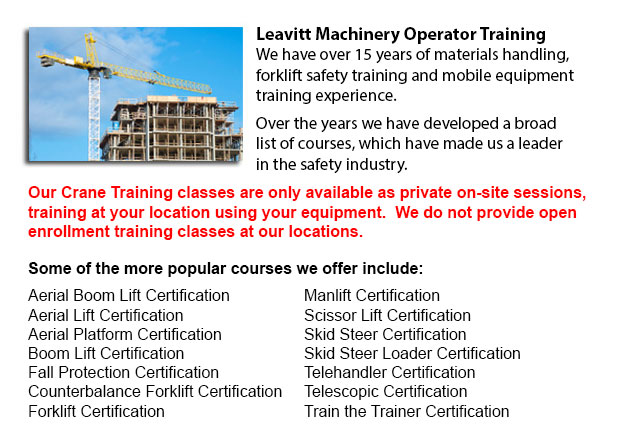
Vernon Crane Operator Classes - For the supervisors and the operators, new and current, the crane operator training course is suitable for all. Course content deals with relevant state, federal and provincial safety regulations. The first part of training consists of comprehensive in-class lessons and exam. After that is a customized hands-on session with practical instruction and evaluation.
The content of the course applies to all categories and types of overhead lifting crane devices. The instruction would particularly focus on all aspects of crane operation which could be done at the trainee's workplace. Upon finishing the course, people training will learn how to operate particular overhead lifting devices, attachments and related parts efficiently and safely.
The operator course's goal is to first identify and potentially dangerous operator habits that can develop while a person operates an overhead crane. Costly damage to products and equipment can be prevented with proper habits. Training reduces the possibility of a workplace incident or injury taking place.
The course would encompass roughly eight hours of classroom instruction with a couple of hours of hands-on customized, on-site training. Participants would be graded on their understanding of training material via written tests and an assessment of their practical knowledge. The minimum acceptable score is eighty percent.
The in-class session, the trainee will know regarding legislation and guidelines, causes of occurrences and damages, hazard awareness, internal responsibility, capacity ratings/load weight calculations, basic equipment and design principles, pre-shift equipment inspections, safe hoisting/operating methods, types of hardware, equipment applications/rigging, angles and hitches, pedestrian/operator safety, turning/flipping loads safely, hand signals for operators and slingers.
The customized practical training and evaluation session should be pre-scheduled. It will be held at the trainees' facility after completion of the in-class session. The length of this practical training component is one to two hours. The instructor would train two operators at a time about skills like right rigging practices, safe operation and planning the lift.
After completing both the practical training and evaluation and the in-class instruction, the trainee would be tested via an exam. Every participant would be needed to sign the safety rules. Trainees who are successful would be provided with individual wallet certificates. A framed wall certificate would be provided to the company.
-
Vernon Heavy Equipment Training Programs
Vernon Heavy Equipment Training Programs - At whatever given construction site, there are often different types of machinery which are ready to be used. These heavy and light machines need both operators to run them and mechanics to fix them. Trainee... More -
Vernon Forklift Safety Training
Vernon Forklift Safety Training - People wanting work in industries that operate lift trucks should undergo a forklift safety training program before becoming a certified operator of a lift truck. There are a lot of ways to go about acquiring forklif... More -
Vernon Aerial Boom Lift Ticket
Vernon Aerial Boom Lift Ticket - Aerial platform lifts can accommodate various odd jobs involving high and tough reaching places. Normally used to complete regular preservation in structures with tall ceilings, prune tree branches, elevate heavy shel... More -
Vernon Manlift Safety Training
Vernon Manlift Safety Training - Manlift operators need to be cognizant and aware of all the potential dangers which are associated with particular classes of scissor lifts. They need to be able to operate the scissor lift in a way that protects not... More -
Vernon Forklift License
Vernon Forklift License - Obtaining a forklift certification or forklift license in North America will require the one training to carry out hands-on training in addition to classroom instruction. The provincial, federal and state regulatory bodies a... More -
Narrow Aisle Forklift, Order Picker, Electric Pallet Jack, Electric Pallet Truck Certification in Vernon
A pallet lift is a model of equipment dedicated in the transporting of pallets of many dimensions and weights. They can be utilized as an appendage for forklifts, cranes and other styles of heavy machinery or be applied on their own. Pallet hoists ar... More -
Vernon Boom Lift Safety Training
Vernon Boom Lift Safey Training - Boom lifts are a type of elevated work platform or aerial lifting device which are commonly utilized in construction, industry, and warehousing. Boom lifts can be utilized in practically any surroundings because of t... More -
Vernon Manlift Operator Training
Vernon Manlift Operator Training - The aerial lift or manlift is a specialized kind of hydraulic platform that is designed to lift a person vertically giving it an alternate name of a vertical personnel lift. These machinery are widely utilized for a... More

Forklift Certification Vernon
TOLL FREE: 1-888-254-6157
Vernon, British Columbia
forkliftcertificationvernon.com
Email Us
About Us


